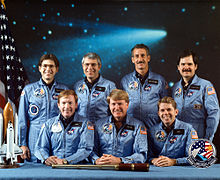Jon McBride
Jon McBride | |
|---|---|
NASA astronaut | |
| Rank | Captain, USN |
Time in space | 8d 5h 23m |
| Selection | NASA Group 8 (1978) |
| Missions | STS-41-G STS-61-E (never flew) |
Mission insignia |   |
| Retirement | May 12, 1989 |
Jon Andrew McBride (born August 14, 1943), is a retired NASA astronaut and American naval officer.
Over the course of his career with the
McBride was also an
Early life, education and personal life
Jon McBride was born August 14, 1943, in
McBride has three children: Richard M. (March 3, 1962 – January 14, 1992),[2] Melissa L. (December 12, 1966), and Jon A. (born October 21, 1970). He has 8 grandchildren: Megan, Collin, Richard, Austin, Cadi, Bailey, Ryan (1999–2021), and Kendall.[3]
Military career
McBride's naval service began in 1965 with flight training at
He attended the
He logged over 8,800 hours flying time—including 4,700 hours in jet aircraft and over 600 carrier landings.
NASA career
Selected as an astronaut candidate by NASA in January 1978, McBride became an astronaut in August 1979. His NASA assignments have included lead

McBride was pilot of STS-41-G, which launched from Kennedy Space Center, Florida, on October 5, 1984, aboard the Orbiter Challenger. This was the first crew of seven. During their eight-day mission, crew members deployed the Earth Radiation Budget Satellite, conducted scientific observations of the Earth with the OSTA-3 pallet and Large Format Camera, and demonstrated potential satellite refueling with an EVA and associated hydrazine transfer. Mission duration was 197 hours and concluded with a landing at Kennedy Space Center, Florida, on October 13, 1984.

McBride was scheduled to fly next in March 1986, as the commander of
On July 30, 1987, McBride was assigned to NASA Headquarters to serve as Assistant Administrator for Congressional Relations, with responsibility for NASA's relationship with the United States Congress, and for providing coordination and direction to all Headquarters and Field Center communications with Congressional support organizations. He held this post from September 1987 through March 1989. In 1988, McBride was named to command the crew of the STS-35 (ASTRO-1) mission, scheduled for launch in March 1990, but chose to retire from NASA instead.
On September 23, 2011, the NASA
In September 2012, at the JSTAR one year celebration, NASA's IV&V Program launched the JSTAR website. The JSTAR website highlights all the work being performed under the JSTAR umbrella at NASA's IV&V facility.
Post-NASA career
Business career
In May 1989, McBride retired from NASA and the U.S. Navy, in order to pursue a business career. He was
Political career
In 1996, he unsuccessfully vied for the
In subsequent years, he left West Virginia to pursue business opportunities in Arizona.
Kennedy Space Center & Retirement
By 2008, McBride was retired and living near Cocoa, Florida. According to a short interview on September 20, 2017, during a "Meet an Astronaut" event, he was also actively working on improving the Space Shuttle Experience ride. He proposed to assist in the development of a landing sequence for the ride.[6][7] McBride remained active supporting the "Lunch with an Astronaut" program at Kennedy Space Center until 2020 when he announced his retirement from duty at the visitor's center.[8]
Organizations
- Association of Naval Aviation
- Veterans of Foreign Wars
- American Legion
- Society of Experimental Test Pilots
- Phi Delta Theta
- National Honor Society
- West Virginia University Engineering Visiting Committee (Chairman, 1990–1992)
- University System of West Virginia Board of Trustees (1992–1995)
- Co-Chairman (with wife), American Cancer Society fund-raising (State of West Virginia) 1990
- Executive Committee, Boy Scouts of America
- President, Association of Space Explorers (USA) (1997–1998)
Executive Committee, Association of Space Explorers (Co-President, 1995–1996)
- March of Dimes
- American Red Cross Disaster Relief
- Shawnee Hills Mental Health Group
Awards and honors
- Legion of Merit
- Defense Superior Service Medal
- Air Medals (3)
- Combat V
- Navy Unit Commendation
- National Defense Service Medal
- Vietnam Service Medal
- NASA Space Flight Medal
- West Virginia Secretary of State's "State Medallion" and appointed "West Virginia Ambassador of Good Will Among All Men" (1980)
- Salem College(1984)
- Honorary Doctorate of Science from West Virginia University (1985)
- Honorary Doctorate of Science from University of Charleston (1987)
- Honorary Doctorate of Science from West Virginia Institute of Technology (1987)
- West Virginia Society's "Son-of-the-Year" (1988), City of Beckley
- West Virginia "Hall of Fame"
- Distinguished Alumni; West Virginia University (1988)
- West Virginia's "Honorary Italian-American" (1988)
- Kanawha County, West Virginia's "Famous Person Award" (1988)
- West Virginia Broadcasters' "Man-of-the-Year" (1989)
- City of Hope's "Spirit of Life Award Winner" (1991)
- Daughters of the American Revolution "Medal of Honor" (1993)
See also
References
- ^ Ogintz, Eileen (March 16, 2009). "Astronaut encounters at Kennedy Space Center". CNN. Archived from the original on March 12, 2012. Retrieved May 8, 2012.
- ^ "Richard M. McBride, LT, USN". U.S. Naval Academy Virtual Memorial Hall. U. S. Naval Academy. Retrieved May 30, 2022.
- ^ "McBride's children". Archived from the original on September 23, 2018. Retrieved April 29, 2015.
- ^ "Jon McBride". Williamson Daily News. May 10, 1996. p. 5A. Retrieved May 8, 2012.
- ISBN 9780847686117. Retrieved May 8, 2012.
- ^ KSC, Jeff Stuckey. "NASA - Space Shuttle Launch Experience". www.nasa.gov. Retrieved September 22, 2017.
- ^ Tapscott, Sean. Personal interview with Jon A. McBride. September 20, 2017.
- ^ Kelly, Emre (January 10, 2020). "NASA astronaut Jon McBride retires from Kennedy Space Center Visitor Complex". Florida Today. Retrieved January 16, 2023.
External links
- "JON A. MCBRIDE (CAPTAIN, USN, RET.) NASA ASTRONAUT (FORMER)" (PDF). NASA. July 2008. Retrieved April 14, 2021.
- Astronautix biography of Jon McBride
- Spacefacts biography of Jon McBride
- McBride at Spaceacts Archived September 23, 2018, at the Wayback Machine
